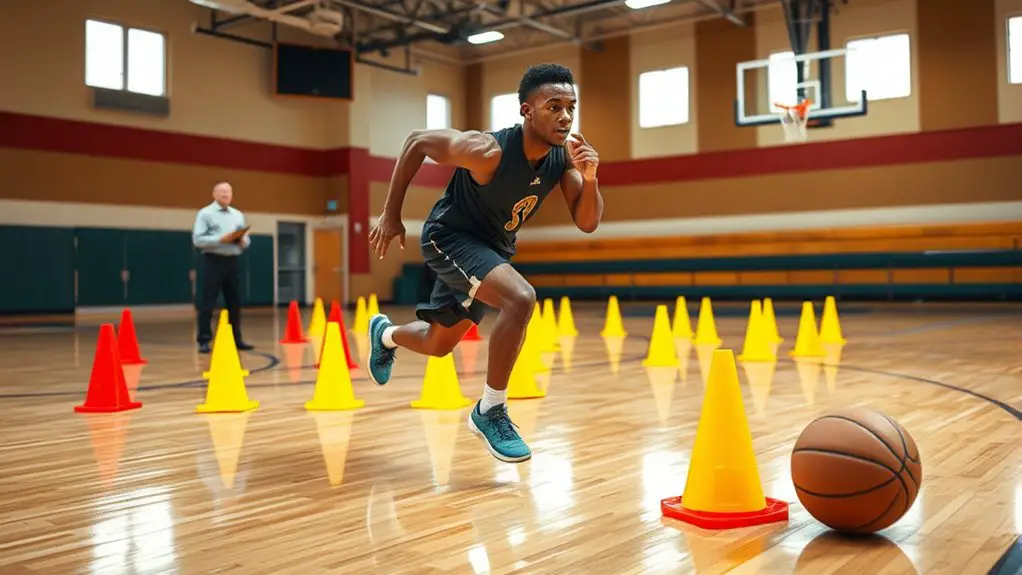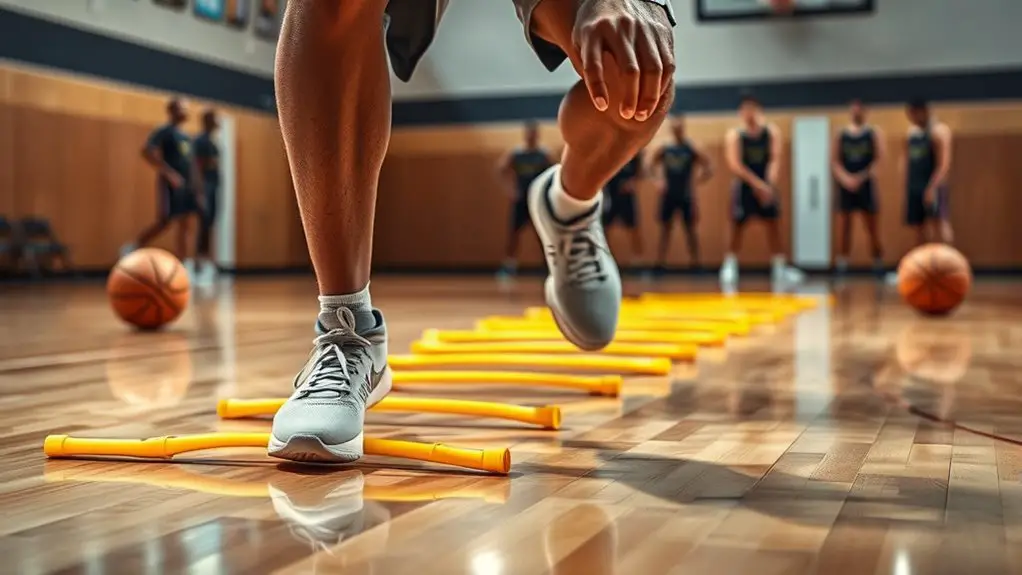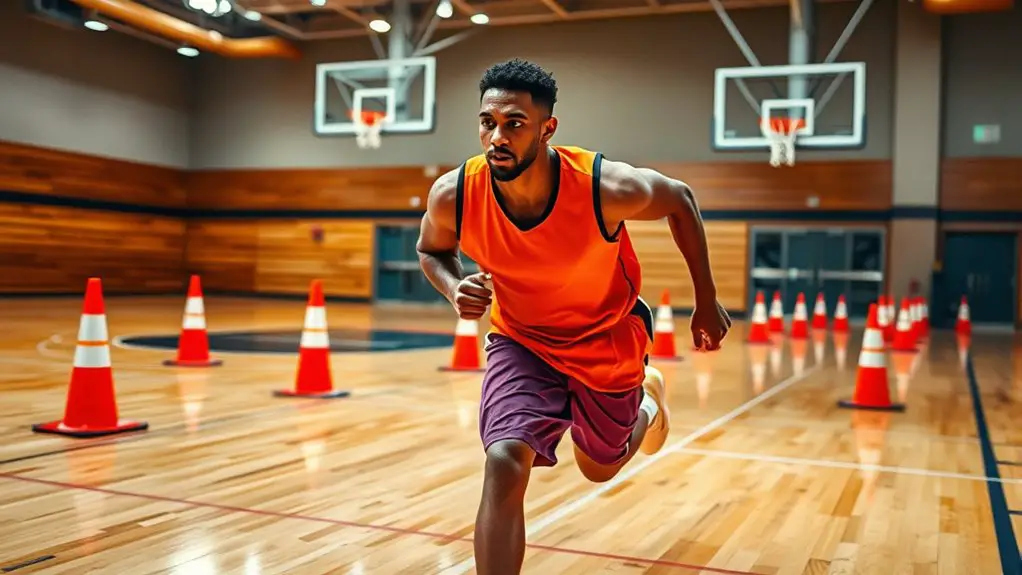Best Agility Drills for Basketball Players in the Gym

To boost your agility on the court, try incorporating ladder drills for foot speed, cone drills for quick direction changes, and shuttle runs for acceleration. Plyometric exercises like box jumps enhance explosiveness, while T-drills focus on lateral movement. Don’t forget about resistance band workouts; they’re great for building strength and agility. These drills will elevate your game considerably. Stick around to discover more techniques and tips for improving your basketball performance.
Ladder Drills for Foot Speed

Ladder drills are an excellent way to boost your foot speed and agility on the basketball court. By incorporating ladder variations into your training routine, you can enhance your coordination and overall performance while minimizing the risk of injury. Safety’s key, so make sure you choose a flat surface and wear proper footwear to maintain grip and stability.
Agility ladder benefits include improved reaction time and better balance, which are essential for quick movements during games. Start with basic patterns like the two-foot in and out, then progress to more complex sequences as you gain confidence.
Always warm up before beginning your drills, and listen to your body to avoid overexertion. Incorporating these drills regularly will not only refine your skills but also contribute to your fitness level. With consistent practice, you’ll notice significant improvements in your footwork on the court.
Cone Drills for Change of Direction
While mastering foot speed is essential, improving your ability to change direction quickly is equally important for basketball players. Cone drills can help you develop this skill effectively and safely. Start by setting up agility cones in various formations, like zigzags or squares, depending on your comfort level.
To begin, focus on your cone placements; ensuring they’re spaced adequately will help prevent injuries. As you maneuver around the cones, practice quick cuts and changes in pace, paying attention to your footwork and body positioning. Remember to maintain a low center of gravity to enhance stability and control.
Incorporating these drills into your routine will not only sharpen your agility but also prepare you for the unpredictable movements in a game. Always warm up before starting, and don’t forget to cool down afterward to aid recovery. With consistent practice, you’ll become more agile and responsive on the court.
Shuttle Runs for Acceleration

Shuttle runs are one of the best drills to boost your acceleration on the basketball court. This drill enhances your sprint mechanics while helping you develop effective acceleration techniques. To perform shuttle runs safely, start by marking two points about 10-20 yards apart. Sprint from one point to the other, then quickly turn and sprint back. Focus on maintaining proper form to avoid injuries—keep your knees high, and drive your arms back and forth vigorously.
It’s essential to warm up before starting to guarantee your muscles are ready for the bursts of speed. Incorporate these runs into your training routine two to three times a week, gradually increasing the distance or speed as you improve. Always stay hydrated and listen to your body; if you feel any pain, take a break. Mastering shuttle runs will not only improve your acceleration but also make you a more agile player on the court.
Plyometric Exercises for Explosiveness
When it comes to boosting your explosiveness on the court, plyometric exercises are key. Box jumps can enhance your vertical leap, while depth jumps help improve your reaction time and power. Let’s explore how these exercises can transform your game.
Box Jumps Benefits
Box jumps are an excellent way to enhance your explosiveness on the basketball court, as they engage multiple muscle groups and improve your overall power. Incorporating box jumps into your routine can bring about several benefits, especially when focusing on box jumps safety and considering box jumps variations. Here are some key advantages:
- Boosts vertical leap for improved dunking ability
- Strengthens leg muscles, enhancing sprinting speed
- Increases coordination and balance for better agility
- Enhances fast-twitch muscle fibers for quick movements
- Provides a great cardio workout, improving stamina
When performing box jumps, always prioritize your safety. Start with a lower box and gradually increase height as you gain confidence and strength. Remember, solid technique is key!
Depth Jumps Explained
Building on the explosiveness developed through box jumps, depth jumps are another effective plyometric exercise that can greatly enhance your performance on the basketball court. This exercise involves stepping off a platform and immediately jumping upon landing, promoting quick force generation. To reap the depth jump benefits, focus on technique optimization; make certain your knees stay aligned and avoid excessive forward lean. Start with a lower platform to minimize injury risk, gradually increasing height as you gain confidence. Engaging your core and maintaining a soft landing will help absorb impact and protect your joints. Incorporate depth jumps into your training regimen for improved vertical leap and overall agility, but always prioritize safety to maximize your athletic potential.
T-drills for Lateral Movement

T-drills are a dynamic way to enhance your lateral movement on the basketball court. By incorporating various t drill variations, you can develop essential lateral movement techniques that improve your agility and speed. Here’s how to perform them safely and effectively:
T-drills are an effective method to boost agility and lateral movement for basketball players.
- Start at the base of the “T” and sprint to the top.
- Side shuffle to the left and touch the line.
- Side shuffle to the right and touch the line.
- Sprint back to the base of the “T.”
- Repeat for multiple sets, focusing on quick, controlled movements.
Always warm up before starting, and make sure you’re in a safe space to avoid injuries. Remember to keep your knees slightly bent and maintain good posture throughout the drill. With consistent practice, you’ll notice improvements in your lateral quickness, which is vital for defensive maneuvers and cutting to the basket.
Box Drills for Balance and Coordination
Box drills are essential for improving your balance and coordination on the court. By incorporating these exercises into your routine, you’ll enhance your overall agility and movement efficiency. Let’s explore how balance training through box drills can elevate your game.
Importance of Balance Training
Balance training is essential for basketball players, as it enhances stability and coordination on the court. When you focus on balance techniques, you improve your overall performance while minimizing the risk of injuries. Here are some key benefits of incorporating stability exercises into your routine:
- Improved agility: Better balance translates to quicker movements.
- Enhanced shooting accuracy: Stable footing helps you shoot with precision.
- Injury prevention: Strengthening stabilizing muscles reduces the risk of falls.
- Increased confidence: A solid foundation boosts your game performance.
- Better body control: You’ll maneuver through defenders more effectively.
Coordination Through Box Drills
One effective way to enhance your coordination and balance is through box drills. These drills help you develop essential balance techniques while improving your footwork. Start with simple coordination exercises that involve moving in and out of a defined box pattern.
Here’s a quick reference table for box drill variations:
| Drill Type | Movement Pattern | Focus Area |
|---|---|---|
| Lateral Shuffle | Side to side | Lower body balance |
| Forward/Backward | In and out | Agility control |
| Diagonal Sprint | Corner to corner | Quick footwork |
Always guarantee a safe environment, using proper footwear and a flat surface. Incorporating these drills into your routine will greatly boost your performance on the court.
Resistance Band Workouts for Strength and Agility
While you might think traditional weight training is the best way to build strength and agility, resistance band workouts offer a versatile and effective alternative. Using band resistance can enhance your strength training routine while improving your agility on the court. Here are some safe and engaging resistance band exercises you can try:
Resistance band workouts provide a versatile alternative to traditional weight training, enhancing strength and agility effectively.
- Lateral Band Walks: Strengthen your hip muscles and improve lateral movement.
- Squat to Press: Combine strength and agility by adding an overhead press as you squat.
- Resisted Sprints: Attach the band to a stable object and practice sprinting to build explosive speed.
- Banded Push-Ups: Use the band for added resistance, enhancing upper body strength.
- Core Rotations: Anchor the band and perform rotations to build core stability and agility.
Incorporating these exercises into your routine can help you develop the strength and agility you need for basketball success, all while keeping safety in mind.
Frequently Asked Questions
How Often Should I Incorporate Agility Drills Into My Training Routine?
You should aim to incorporate agility drills into your training routine about two to three times a week. It’s important to balance training frequency with proper recovery to avoid injuries. Mixing up drill variety keeps your workouts engaging and targets different muscle groups. Always listen to your body; if you’re feeling fatigued, it’s okay to back off. Safety should always come first, so make sure you’re warmed up before starting any drills.
Can Agility Drills Improve My Overall Basketball Performance?
Absolutely, agility drills can greatly improve your overall basketball performance. By incorporating agility techniques into your training, you enhance your quickness, coordination, and reaction time. These performance benefits help you navigate the court more effectively and outmaneuver opponents. Just remember to focus on safety; always warm up properly and use the correct form to prevent injuries. With consistent practice, you’ll notice a marked improvement in your game.
What Is the Best Time of Day to Perform Agility Drills?
Morning may maximize motivation, but evening sessions can enhance energy. You should choose a time that feels right for you; early workouts might spark your day, while later sessions may fit your routine better. Regardless of when you train, prioritize safety—ensure you’re warmed up to prevent injuries. Listen to your body, and find that sweet spot where agility drills can shine, allowing you to boost your performance without compromising your well-being.
Are There Any Safety Precautions to Consider During Agility Training?
When you’re doing agility training, it’s essential to take into account safety precautions to avoid injuries. Always start with a proper warm-up routine to prepare your muscles and joints. Make sure your training area is clear of obstacles and has a non-slip surface. Wearing appropriate footwear can also help prevent slips and falls. Finally, listen to your body; if you feel pain, it’s better to stop and reassess rather than risk further injury.
How Can I Track My Progress With Agility Drills?
Did you know that athletes who regularly track their agility progress can improve their performance by up to 20%? To effectively monitor your progress with agility drills, consider using progress metrics like time taken for shuttle runs or the number of successful ladder drills completed. Regular agility assessments will help you identify areas for improvement. Always prioritize safety; make certain you’re warming up properly and using appropriate gear to reduce the risk of injury.





